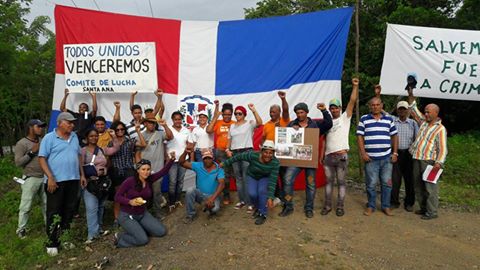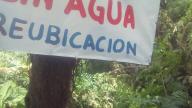Guest Blog: Ryan MacRae, Economics Graduate from Mount Allison University working with the Latin American Mission's Program (LAMP) in Dominican Republic
(Dominican Republic) Driving along the highway, roughly 10 minutes after passing through the community of Maimón, you begin to hear it: the faint sound of merengue music blasting from large speakers off in the distance. As you approach closer, the sound intensifies, until the scene finally unveils itself from atop a hill on the side of the highway. A small hut with tarps stretching out above groups of people sitting in circles chatting, some playing dominos while others are busy cooking in giant pots over an open fire. Some folks busy themselves hanging up signs and posters, while others who have just arrived are helping their children off the back of their motorcycles. Even though the smell of sulphur is strong in the air, the energy, life and sense of community are strong at the Barrick Gold Resistance Camp.
It wasn’t long ago that this camp was stationed in front of the tunnel to the entrance of the Barrick Gold mine in Pueblo Viejo, underneath a giant tree at the fork in the road. Unfortunately, the camp had to relocate a few months ago after authorities demolished the camp late one night, even uprooting the beautiful tree which supported its structure. The camp’s new location further up the highway offers a larger space, and sits facing the enormous mine, where Barrick Gold trucks roar up and down the roads during the mine’s 24/7 operation.
November 6, 2018 marks the one-year anniversary of the camp, whose protest focuses on relocating the six communities which the mine surrounds: La Piñita, La Cerca, La Laguna, El Naranjo, Jurungo, and Jubo Claro. They claim the environmental damage from the mine has made life unliveable and demand immediate relocation by Barrick Gold and/or the government of the Dominican Republic.
In 2002, Canadian company Placer Dome received special permission from the Dominican government to take control of the Pueblo Viejo Mining Complex, which they claimed to be the largest gold deposit in the Americas, on a 33-year contact. This act revoked ownership from state-owned Rosario Dominicana, which had operated the mine from 1975 until 1999. Barrick acquired Placer Dome in 2006 and would eventually sell 40 percent of the project to its current operating partner, Goldcorp Inc. The joint venture, known today as Pueblo Viejo Dominicana Corporation, finally began gold production at the mine on August 14, 2012.
Although Rosario had been operating in the region for 24 years prior to Barrick’s arrival, the community says the environmental damage has been exponentially amplified with the Canadian company’s arrival. Since 2012, the main water source for the communities, the Maguaca river, has been contaminated by pollutants, likely from the giant body of water which hangs in a valley above the surrounding communities where Barrick stores the water used in the gold mining process.
Stories of livestock dying after drinking from the river are plentiful, and many members of the community display horrific skin conditions after having come in contact with the water. With their main water source contaminated, the government has been issuing four five-gallon water jugs per household per week – hardly enough to sustain an entire family.
The damage has also seeped its way into local agricultural production, where many fruits and vegetables haven’t been edible over the last five years. With the leaves of the yuca plants yellowed by acidic rain, and the milk from the coconuts revealing a rotten, black colour, many of the area’s inhabitants have to travel to the nearby towns of Maimón or Cotui to purchase reliable produce.
As per Dominican law, communities where mining activity is present are entitled to 5% of company profits, but unfortunately this compensation is yet to arrive in the hands of community members. With few and infrequent working opportunities for nearby community members at the mine - reportedly only 2 or 3 month contracts for a select few people, every few years - some people are struggling to make ends meet.
And so the community has been committed to fighting for justice for their friends and families, and the land upon which they live. Although it’s been a long, draining battle against a giant Canadian mining company, the fight seems stronger than ever. The Espacio Nacional por la Transparencia de la Industria Extractiva (ENTRE) is a supporting body for the community resistance which has begun discussions with the Ministry of Energy and Mines in hopes that the resettlement of these at-risk communities can be accomplished.
After a hefty meal and a few hours of palodancing and drumming in the rain, the group assembles to prepare for a march to the entrance of the mine. A community organizer stands up on a plastic chair and makes a promise to her allies,
“Over the past year we have fought hard, but in the coming year we will be even more vocal, and even more aggressive. We will continue to push for the future of our communities!”


